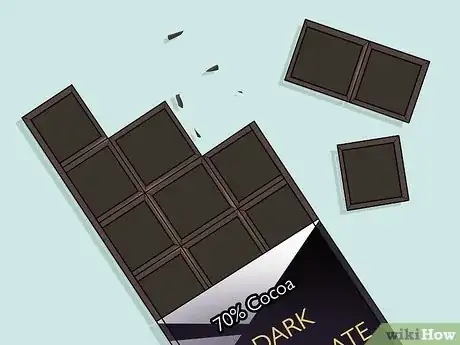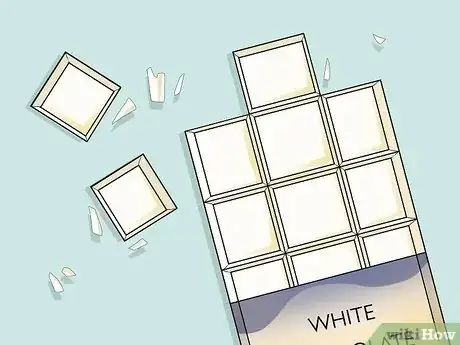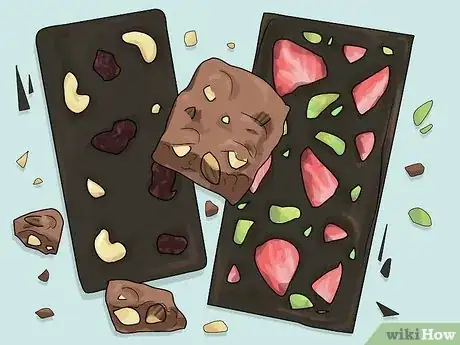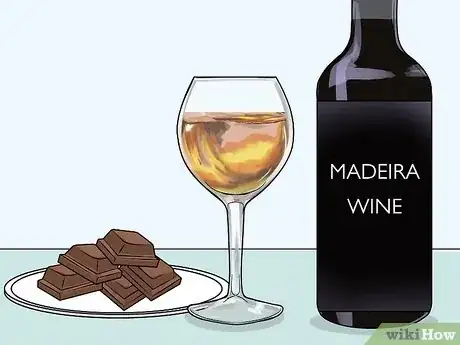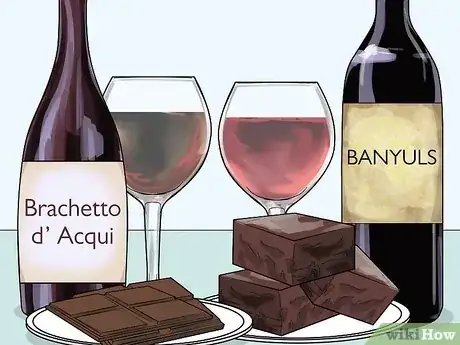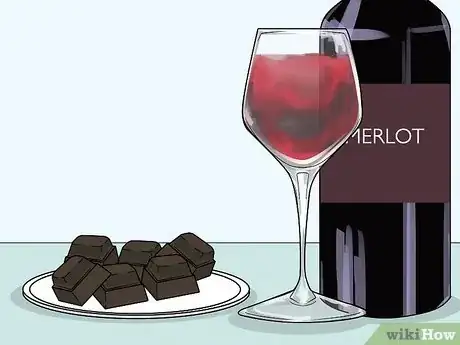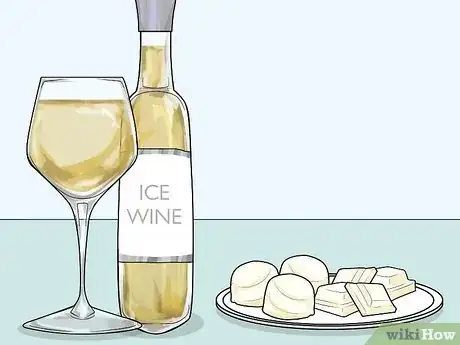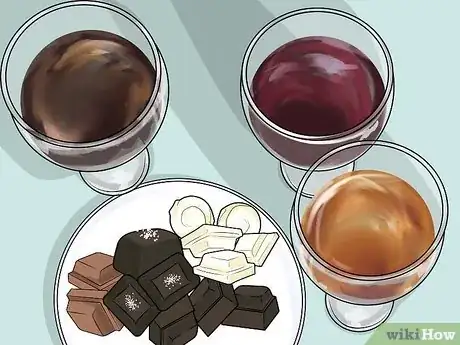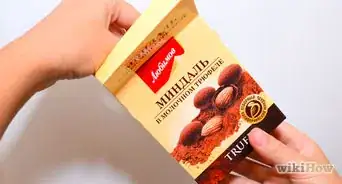This article was co-authored by Samuel Bogue and by wikiHow staff writer, Megaera Lorenz, PhD. Samuel Bogue is a sommelier based in San Francisco, California. He is the Wine Director of the renouned Ne Timeas Restaurant Group and a wine consultant for other top restaurants in the San Francisco Bay area. He gained his Sommelier certification in 2013, and since then has been recognized as a Zagat "30 Under 30" award winner and a Star Chefs Rising Star.
There are 9 references cited in this article, which can be found at the bottom of the page.
This article has been viewed 157,203 times.
People often think of wine and chocolate as going together. They are both decadent, luxurious, and packed with complex flavors. Both are also associated with romantic or indulgent moments. But the intense flavors of both wine and chocolate can clash on your palate if you don’t match your selections carefully. After you’ve selected your chocolate, pick the right kind of wine to go with it. Then, take time to appreciate your delicious pairing.
Steps
Selecting Your Chocolate
-
1Choose dark chocolate for a more intense flavor. Dark chocolate is composed of 35-70+% chocolate (liquor and cocoa butter). The higher the percentage of chocolate, the more bitter the chocolate will taste.[1]
- The intensity of dark chocolate can be overwhelming when combined with wine, especially if the wine is dry or bitter.
- If you’re interested in getting the maximum health benefits out of your chocolate, dark chocolate is the way to go. It contains the highest concentrations of anti-oxidant flavanols.
- The percentage of cocoa in the chocolate is usually listed on the label.
-
2Pick milk chocolate for a sweeter flavor and creamy texture. Milk chocolate usually contains a lower percentage of liquor than dark chocolate. However, the primary difference is that milk chocolate contains at least 12% milk solids, which are absent from dark chocolate. The milk powder gives milk chocolate its classic creamy taste and texture, along with a lighter color.[2]
- If you crave the more bitter taste of dark chocolate along with the creamy goodness of milk chocolate, consider a “dark milk chocolate,” which can contain up to 42% chocolate liquor.
Advertisement -
3Select white chocolate for the sweetest flavor. White chocolate contains no chocolate liquor at all, which means that it is technically not a true chocolate. It is composed of cocoa butter, milk, and sweeteners. It is the sweetest and mildest of all the varieties of chocolate.[3]
-
4Try chocolate with fruit, nuts, or other additives. For a more complex flavor and texture experience, choose chocolate that contains nuts or other additions, like sea salt, caramel, hazelnut liquor, or even red pepper. Fruit dipped in chocolate can also make an interesting pairing with wine.[4]
-
5Give inexpensive chocolate treats a chance. You don’t have to limit yourself to fancy, high-end chocolates to achieve a delicious and fun pairing. Consider pairing wine with a classic candy bar, chocolate kisses, or peanut butter cups.[5]
Choosing Your Wine
-
1Go for a sweet wine. If the chocolate is sweeter than the wine you select, the wine will taste acrid or bitter in contrast. Your wine should be at least as sweet as the chocolate you plan to pair with it. Look for a wine that is fruity and sweet rather than bitter and dry.[6]
- For example, if you’re eating sweet chocolate, opt for a dessert wine like port, Madeira, or sweet sherry rather than a drier Pinot Noir.
- Some white dessert wines work well with sweet chocolates, too. Moscato and ice wine are both good choices.
-
2Match the weight and texture of the wine with the chocolate. In addition to the sweetness of the chocolate, consider how rich, heavy, or creamy it is. Select a wine that matches the weight and intensity of the dessert.[7]
- For example, a simple, bittersweet chocolate bar might go well with a light, sparkling, fruity wine, like a Brachetto d’Acqui.
- A rich and creamy piece of fudge or chocolate cake will pair well with a heavier, more syrupy fortified wine, like Banyuls or Maury.
-
3Try a fruity red wine with dark chocolate. If you’re eating bitter dark chocolate, you can get away with a less sweet wine. The wine you select should be fruity, low in tannins, and not super dry or acidic.[8]
- Some good options include warm climate Cabernet Sauvignon, Merlot, or Petit Syrah.
- For a sweeter, heavier companion to your dark chocolate, try port.
-
4Drink a sweet or dessert wine with milk chocolate. Milk chocolate is sweeter than dark chocolate, so it will go best with a sweeter wine. Try a sweet or semi-sweet wine, like Moscatel, PX Sherry, Port, Zinfandel, or Vino Santo.[9]
-
5Pair white chocolate with a dessert wine. Since white chocolate is extremely sweet, it will taste best when paired with a very sweet wine. Ice wine, which is made by allowing the grapes to freeze on the vine before fermenting, is an especially popular pairing with white chocolate.[10]
-
6Pair the wine with other flavors in your chocolate. If you’re eating chocolate mixed with fruit, nuts, caramel, or other flavors, take the additional flavors into account when selecting your wine. A good wine pairing will help bring out the other flavors in the chocolate. For example:[11]
- Chocolate with peanuts pairs well with Banyuls, a syrupy dessert wine with a spicy strawberry flavor. Banyuls also goes well with desserts that include berries.[12]
- Chocolate with caramel and sea salt pairs well with red wines that have berry, chocolate, or spicy notes. Try combining dark chocolate with caramel and salt with a Cabernet Sauvignon and Malbec blend.[13]
Appreciating Your Pairing
-
1Keep an open mind. Remember that wine pairing guidelines are just that: guidelines. Although most wine connoisseurs wouldn’t recommend it, you might love the contrast of a super-sweet white chocolate with an ultra-dry red wine. The only way to know what you like is to try different things.[14]
-
2Cleanse your palate. To really appreciate the tastes of wine and chocolate together, use a simple palate cleanser to get any lingering flavors from dinner out of your mouth. Eat something with a neutral flavor, like a few bites of white bread, and drink a little water.[15]
-
3Smell before you taste. Your sense of smell contributes a lot to what you taste. Inhaling the aroma of your food and drink first can help you appreciate the various flavors more fully. It can also build your anticipation by giving you a preview of what your taste buds are about to experience.[16]
- Hold each piece of chocolate to your nose and take a moment to inhale deeply before you bite.
- Before taking a sip of wine, swirl the glass gently, then take a series of quick, short sniffs from just above the top of the glass.[17]
-
4Taste the chocolate before sipping the wine. Take a small bite of chocolate, and allow it to melt enough to coat the inside of your mouth. Close your eyes and concentrate on what you feel and taste. Make note of:[18]
- The texture. Is it smooth and creamy? Does it have a crumbly or fudgy texture? If your chocolate contains nuts, sea salt, or bits of nougat, what do they contribute to the texture?
- The flavor. Is it bitter, sweet, or both? Are there fruity or salty notes? Do you detect hints of almond or hazelnut?
-
5Sip the wine immediately after swallowing the chocolate. Take a quick sniff of the wine, then take a sip while the taste of the chocolate is still lingering in your mouth. Pay attention to the feel and taste of the wine, and think about how it mingles with the flavors of the chocolate.
- For example, does the wine feel smooth, or crisp? Does the texture work well with the texture of the chocolate?
- Do you notice any notes in the wine that complement the chocolate particularly well? For example, hints of berry can go particularly well with dark or milk chocolate.
-
6Take your time. Allow yourself to be in the moment and savor the mingling of the flavors. Close your eyes and take a few moments to concentrate entirely on the taste of the chocolate and the wine. Wait a few moments between tastes to appreciate the aftertaste that lingers after you have swallowed both the chocolate and the wine.
Expert Q&A
-
QuestionIs wine good with chocolate?
 Samuel BogueSamuel Bogue is a sommelier based in San Francisco, California. He is the Wine Director of the renouned Ne Timeas Restaurant Group and a wine consultant for other top restaurants in the San Francisco Bay area. He gained his Sommelier certification in 2013, and since then has been recognized as a Zagat "30 Under 30" award winner and a Star Chefs Rising Star.
Samuel BogueSamuel Bogue is a sommelier based in San Francisco, California. He is the Wine Director of the renouned Ne Timeas Restaurant Group and a wine consultant for other top restaurants in the San Francisco Bay area. He gained his Sommelier certification in 2013, and since then has been recognized as a Zagat "30 Under 30" award winner and a Star Chefs Rising Star.
Certified Sommelier Yes, but find a wine that's sweeter than your chocolate. When you're pairing sweeter foods, if the dish is sweeter than the wine, often it will make the wine fall a little flat. In our restaurant, we try to serve dessert wines that have a bit more sugar in them than the dessert that we're serving.
Yes, but find a wine that's sweeter than your chocolate. When you're pairing sweeter foods, if the dish is sweeter than the wine, often it will make the wine fall a little flat. In our restaurant, we try to serve dessert wines that have a bit more sugar in them than the dessert that we're serving. -
QuestionWhat type of wine should we have with a dessert of mint chocolate and mint sorbet?
 Community AnswerMint can pair nicely with merlot, syrah, and pinotage.
Community AnswerMint can pair nicely with merlot, syrah, and pinotage. -
QuestionWhat is the best wine for peppered milk chocolate?
 Community AnswerA spicy dark wine like a red zinfandel or a malbec is probably a good place to start. You could also try a sweet dessert wine.
Community AnswerA spicy dark wine like a red zinfandel or a malbec is probably a good place to start. You could also try a sweet dessert wine.
References
- ↑ https://www.iddba.org/training-materials/pdfs/jg-choctype.aspx?ext=.pdf
- ↑ https://www.iddba.org/training-materials/pdfs/jg-choctype.aspx?ext=.pdf
- ↑ https://www.iddba.org/training-materials/pdfs/jg-choctype.aspx?ext=.pdf
- ↑ http://www.foodandwine.com/articles/march-2008-pairing-chocolate-and-wine
- ↑ http://www.marieclaire.com/food-cocktails/news/a16135/wine-chocolate-pairings/
- ↑ http://drinks.seriouseats.com/2014/02/sommelier-pairing-wine-and-chocolate-which-wines-go-with-chocolate-valentines-day-advice.html
- ↑ http://drinks.seriouseats.com/2014/02/sommelier-pairing-wine-and-chocolate-which-wines-go-with-chocolate-valentines-day-advice.html
- ↑ http://www.businessinsider.com/the-best-wine-and-chocolate-pairings-2012-9
- ↑ https://www.winerist.com/blog/entry/best-wine-and-chocolate-pairings
- ↑ https://www.winerist.com/blog/entry/best-wine-and-chocolate-pairings
- ↑ https://www.winerist.com/blog/entry/best-wine-and-chocolate-pairings
- ↑ http://drinks.seriouseats.com/2014/02/sommelier-pairing-wine-and-chocolate-which-wines-go-with-chocolate-valentines-day-advice.html
- ↑ https://www.winerist.com/blog/entry/best-wine-and-chocolate-pairings
- ↑ http://www.businessinsider.com/the-best-wine-and-chocolate-pairings-2012-9
- ↑ http://www.wineloverspage.com/wlp_archive/questionary2/cleansing_the_palate_what_to_u.php
- ↑ http://www.foodrepublic.com/2016/02/10/how-to-taste-chocolate-like-you-know-what-youre-doing/
- ↑ http://www.winemag.com/2015/08/25/how-to-taste-wine/
- ↑ http://www.foodrepublic.com/2016/02/10/how-to-taste-chocolate-like-you-know-what-youre-doing/
